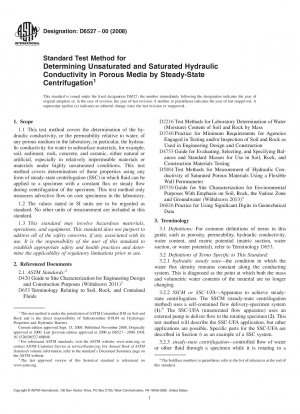ASTM D6527-00(2008)
Standard Test Method for Determining Unsaturated and Saturated Hydraulic Conductivity in Porous Media by Steady-State Centrifugation
- Standard No.
- ASTM D6527-00(2008)
- Release Date
- 2000
- Published By
- American Society for Testing and Materials (ASTM)
- Latest
- ASTM D6527-00(2008)
- Scope
Recent results have demonstrated that direct measurements of unsaturated transport parameters, for example, hydraulic conductivity, vapor diffusivity, retardation factors, thermal and electrical conductivities, and water potential, on subsurface materials and engineered systems are essential for defensible site characterization needs of performance assessment as well as restoration or disposal strategies. Predictive models require the transport properties of real systems that can be difficult to obtain over reasonable time periods using traditional methods. Using a SSC-UFA greatly decreases the time required to obtain direct measurements of hydraulic conductivity on unsaturated systems and relatively impermeable materials. Traditionally, long times are required to attain steady-state conditions and distributions of water because normal gravity does not provide a large enough driving force relative to the low conductivities that characterize highly unsaturated conditions or highly impermeable saturated systems (Test Method D 5084
). Pressure techniques sometimes can not be effective for measuring unsaturated transport properties because they do not provide a body force and cannot act on the entire specimen simultaneously unless the specimen is saturated or near-saturated. A body force is a force that acts on every point within the system independently of other forces or properties of the system. High pressures used on saturated systems often induce fracturing or grain rearrangements and cause compaction as a result of high-point stresses that are generated within the specimen. A SSC-UFA does not produce such high-point stresses. There are specific advantages to using centrifugal force as a fluid driving force. It is a body force similar to gravity and, therefore, acts simultaneously over the entire system and independently of other driving forces, for example, gravity or matric potential. Additionally, in a SSC-UFA the acceleration can dominate any matric potential gradients as the Darcy driving force. The use of steady-state centrifugation to measure steady-state hydraulic conductivities has recently been demonstrated on various porous media (1,2).
Several issues involving flow in an acceleration field have been raised and addressed by previous and current research (1,4). These studies have shown that compaction from acceleration is negligible for subsurface soils at or near their field densities. Bulk densities in these specimens have remained constant (±0.1 g/cm3) because the specimens are already compacted more than the acceleration can affect them. The notable exception is structured soils. Special arrangements must be made to preserve their densities, for example, the use of speeds not exceeding specific equivalent stresses. As an example, for most SSC-UFA specimen geometries, the equivalent pressure in the specimen at a rotation speed of 2500 rpm is about 2 bar. If the specimen significantly compacts under this pressure, a lower speed must be used. Usually, only very fine soils at dry bulk densities less than 1.2 g/cm3 are a problem. Whole rock, grout, ceramics, or other solids are completely unaffected by these accelerations. Precompaction runs up to the highest speed for that run are performed in the SSC-UFA prior to the run to observe any compaction effects.
Three-dimensional deviations of the driving force as a function of position in the specimen are less than a factor of two. Theoretically, the situation under which unit gradient conditions are achieved in a SSC-UFA, in which the change in the matric potential with radial distance equals zero (dψ/dr = 0), is best at higher water flux densities, higher speeds, or coarser grain-size, or combination thereof. This is observed in pot........
ASTM D6527-00(2008) Referenced Document
- ASTM D2216 Standard Test Method for Laboratory Determination of Water (Moisture) Content of Soil and Rock by Mass
- ASTM D3740 Standard Practice for Minimum Requirements for Agencies Engaged in the Testing and/or Inspection of Soil and Rock as Used in Engineering Design and Construction
- ASTM D420 Standard Guide to Site Characterization for Engineering Design and Construction Purposes
- ASTM D4753 Standard Specification for Evaluating, Selecting, and Specifying Balances and Scales for Use in Soil, Rock, and Construction Materials Testing
- ASTM D5084 Standard Test Methods for Measurement of Hydraulic Conductivity of Saturated Porous Materials Using a Flexible Wall Permeameter
- ASTM D5730 Standard Guide for Site Characterization for Environmental Purposes With Emphasis on Soil, Rock, the Vadose Zone and Ground Water
- ASTM D6026 Standard Practice for Using Significant Digits in Geotechnical Data
- ASTM D653 Standard Terminology Relating to Soil, Rock, and Contained Fluids
ASTM D6527-00(2008) history
- 2000 ASTM D6527-00(2008) Standard Test Method for Determining Unsaturated and Saturated Hydraulic Conductivity in Porous Media by Steady-State Centrifugation
- 2000 ASTM D6527-00 Standard Test Method for Determining Unsaturated and Saturated Hydraulic Conductivity in Porous Media by Steady-State Centrifugation
